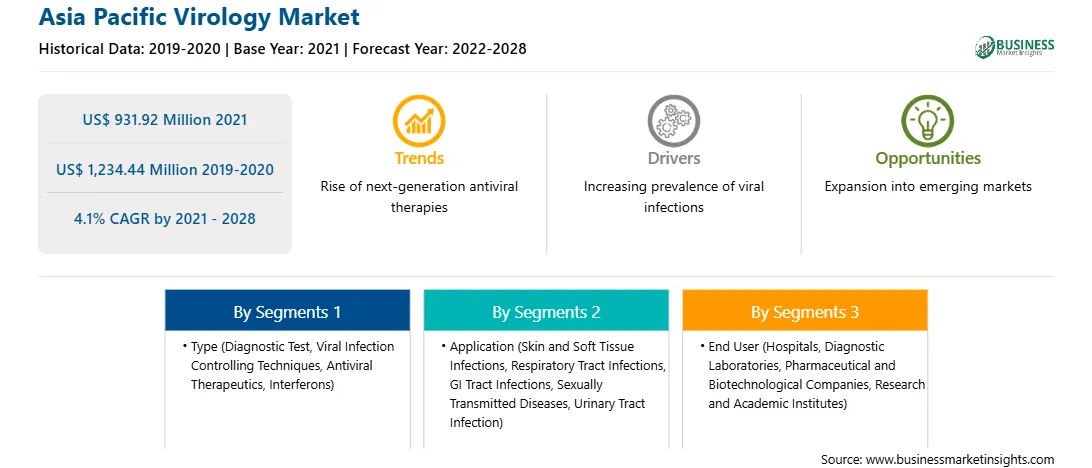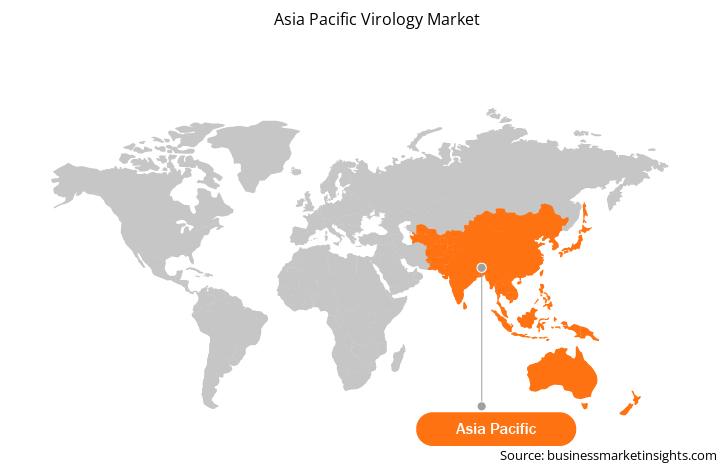Asia Pacific consists of five major countries namely China, Japan, India, Australia, South Korea, and the rest of Asia Pacific. The market is also evaluated for the rest of countries in Asia Pacific. The market is driven by the factors such as large population countries such as China and India, increasing focus of market players on this region, and introduction of new products in the country. Moreover, increasing incidences of influenza, HIV, and other infectious diseases are driving the market growth. In addition, growing awareness on better treatment procedures and advancement in technology, increased in healthcare spending and availability of advanced technology helps to boost the growth of virology market in the region. Surging growth in emerging economies is the major factor driving the growth of the APAC virology market.
COVID-19 has created an unprecedented public health emergency globally. It has demonstrated, emerging infectious diseases represent an existential threat worldwide. Rapid urbanization, deforestation, intensive agriculture, livestock rearing practices, and globalization are increasing opportunities for animal-to-human contacts and epidemics in the region. Urbanization is creating greater potential for epidemics and pandemics, as a large population now lives in cities. In addition, many countries were able to contain the COVID-19 based on previous epidemics. For instance, the South Korean central government began investing in domestic R&D of diagnostic reagents necessary for infectious disease testing. From 2017, it has invested approximately US$ 25 million in infectious disease diagnosis technology. The testing technologies developed by commercial manufacturers through government investments in R&D, including artificial intelligence (AI), proved critical for the government’s rapid launch of an effective COVID-19 response strategy. However, The COVID-19 pandemic has had a major impact on the essential HIV health services in the South East Asia Region, putting the growth at risk over the last two decades. COVID-19 has disrupted essential services causing considerable delays in the delivery of medicines and other health commodities. Changing priorities for HIV clinics and healthcare workers, travel restrictions, non-availability of public and limited private transportation, and worsening socio-economic contexts affected the continuity of essential HIV services. In the Philippines, more than 70% of delays or reductions in the number of visits to HIV clinics have been recorded since the pandemic, according to a survey conducted by Gilead Sciences. HIV and AIDS represented the most recent global pandemic, and the Global Fund has made enormous progress over the past 20 years. According to the study, over 82% of prescribers in India reported a decrease or delay of visits of people living with HIV. COVID-19 has also negatively impacted the uptake of HIV tests, and around 46% of the at-risk population reported a decrease in taking HIV tests during COVID-19. The main reasons for reduced testing were exposure to COVID-19 (62%) and travel restrictions (46%), as HIV tests were mostly only accessible at point-of-care. Therefore, it has negatively affected HIV care and other virus infections.

Strategic insights for the Asia Pacific Virology provides data-driven analysis of the industry landscape, including current trends, key players, and regional nuances. These insights offer actionable recommendations, enabling readers to differentiate themselves from competitors by identifying untapped segments or developing unique value propositions. Leveraging data analytics, these insights help industry players anticipate the market shifts, whether investors, manufacturers, or other stakeholders. A future-oriented perspective is essential, helping stakeholders anticipate market shifts and position themselves for long-term success in this dynamic region. Ultimately, effective strategic insights empower readers to make informed decisions that drive profitability and achieve their business objectives within the market.

| Report Attribute | Details |
|---|---|
| Market size in 2021 | US$ 931.92 Million |
| Market Size by 2028 | US$ 1,234.44 Million |
| Global CAGR (2021 - 2028) | 4.1% |
| Historical Data | 2019-2020 |
| Forecast period | 2022-2028 |
| Segments Covered |
By Type
|
| Regions and Countries Covered | Asia-Pacific
|
| Market leaders and key company profiles |
The geographic scope of the Asia Pacific Virology refers to the specific areas in which a business operates and competes. Understanding local distinctions, such as diverse consumer preferences (e.g., demand for specific plug types or battery backup durations), varying economic conditions, and regulatory environments, is crucial for tailoring strategies to specific markets. Businesses can expand their reach by identifying underserved areas or adapting their offerings to meet local demands. A clear market focus allows for more effective resource allocation, targeted marketing campaigns, and better positioning against local competitors, ultimately driving growth in those targeted areas.

The virology market in APAC is expected to grow from US$ 931.92 million in 2021 to US$ 1,234.44 million by 2028; it is estimated to grow at a CAGR of 4.1% from 2021 to 2028. Viral infection is among the leading causes of human chronic diseases. A few viruses, such as human immunodeficiency virus (HIV), flu virus, Zika, Diphtheria, Ebola, SARS-CoV-2 (COVID-19), Polio, and Tetanus (Lockjaw), infect large populations across the world. As virus mutate and evolve continuously, drug resistance become an impending challenge for viral infection management among the human and animals. A virus transmits through various mediums based on its type. For instance, some viruses cause respiratory viral diseases, such as flu, common cold, and respiratory syncytial virus infection, transmits through droplets generated through coughing or sneezing; while some because gastrointestinal viral diseases transmitted through feces contaminated food or water. As per the UN Aids HIV & AIDS statistics, more than 37.7 million people across the world were infected by HIV in 2020. The novel coronavirus that causes COVID-19 was identified in 2019. The International Committee on Taxonomy of Viruses (ICTV) declared the virus as Severe Acute Respiratory Syndrome Coronavirus 2 (SARS-CoV-2) on February 11, 2020, and later WHO named the disease as COVID-19. The virus has undergone mutation a couple of times since its outbreak, which has added to the severity of the COVID-19 pandemic. Therefore, the rising prevalence of viral infections drives the growth of the APAC virology market.
The APAC virology market is segmented on the bases of type, application, end user, and country. Based on type, the market is segmented into diagnostic test, viral infection controlling techniques, antiviral therapeutics, and interferons. The antiviral therapeutics segment dominated the market in 2020, and viral infection controlling techniques segment is expected to be the fastest growing during the forecast period. The diagnostic test segment is further categorized into DNA virus testing, RNA virus testing, others. Similarly, the viral infection controlling techniques is bifurcated into active prophylaxis, and passive prophylaxis. Likewise, the antiviral therapeutics segmented is categorized into virucidal agents, antiviral agents, immunomodulators, and interferons. On the basis of application, the virology market is segmented into skin and soft tissue infections, respiratory tract infections, GI tract infections, sexually transmitted diseases, urinary tract infections, and others. The respiratory tract infections segment dominated the market in 2020, and is expected to be the fastest growing during the forecast period. On the basis of end user, the virology market is segmented into hospitals, diagnostic laboratories, pharmaceutical and biotechnological companies, and research and academic institutes. The hospitals segment dominated the market in 2020, and diagnostic laboratories segment is expected to be the fastest growing during the forecast period.
A few major primary and secondary sources referred to for preparing this report on the virology market in APAC are company websites, annual reports, financial reports, national government documents, and statistical database, among others. Major companies listed in the report are Abbott; AbbVie Inc.; F. Hoffmann-La Roche Ltd.; Gilead Sciences, Inc.; GlaxoSmithKline Plc; Illumina, Inc.; Johnson and Johnson Services, Inc.; QIAGEN; Siemens AG; and Thermo Fisher Scientific Inc. are among others.
The Asia Pacific Virology Market is valued at US$ 931.92 Million in 2021, it is projected to reach US$ 1,234.44 Million by 2028.
As per our report Asia Pacific Virology Market, the market size is valued at US$ 931.92 Million in 2021, projecting it to reach US$ 1,234.44 Million by 2028. This translates to a CAGR of approximately 4.1% during the forecast period.
The Asia Pacific Virology Market report typically cover these key segments-
The historic period, base year, and forecast period can vary slightly depending on the specific market research report. However, for the Asia Pacific Virology Market report:
The Asia Pacific Virology Market is populated by several key players, each contributing to its growth and innovation. Some of the major players include:
The Asia Pacific Virology Market report is valuable for diverse stakeholders, including:
Essentially, anyone involved in or considering involvement in the Asia Pacific Virology Market value chain can benefit from the information contained in a comprehensive market report.